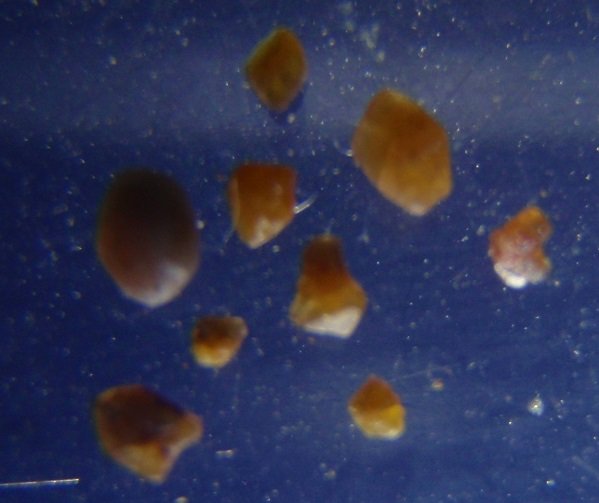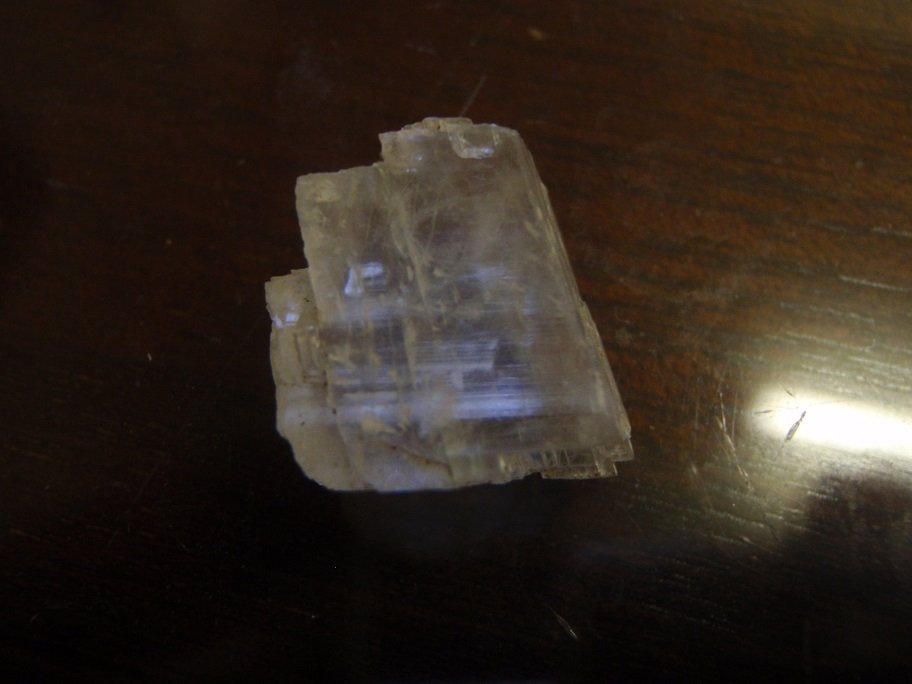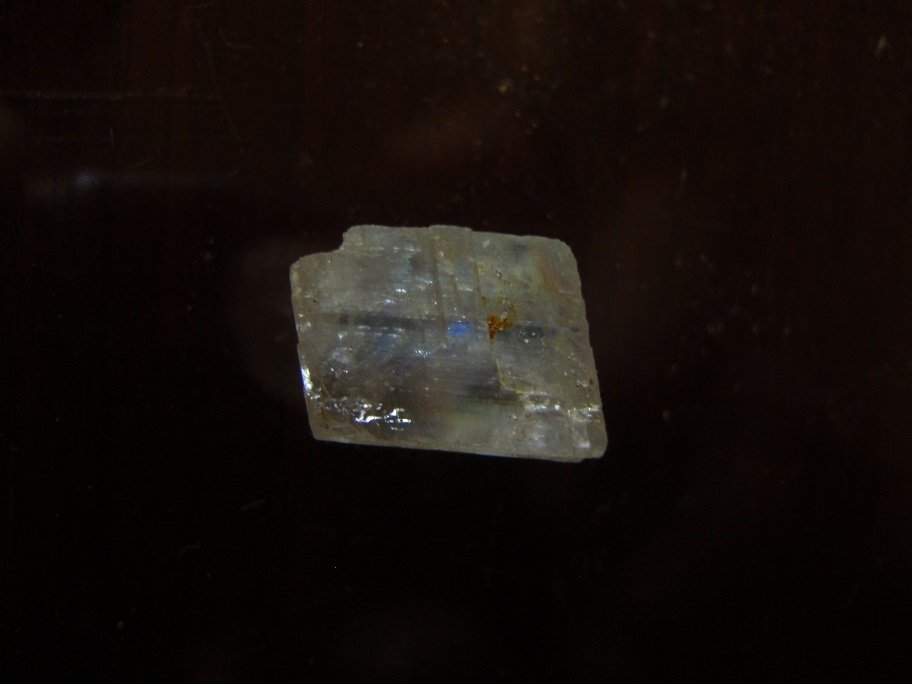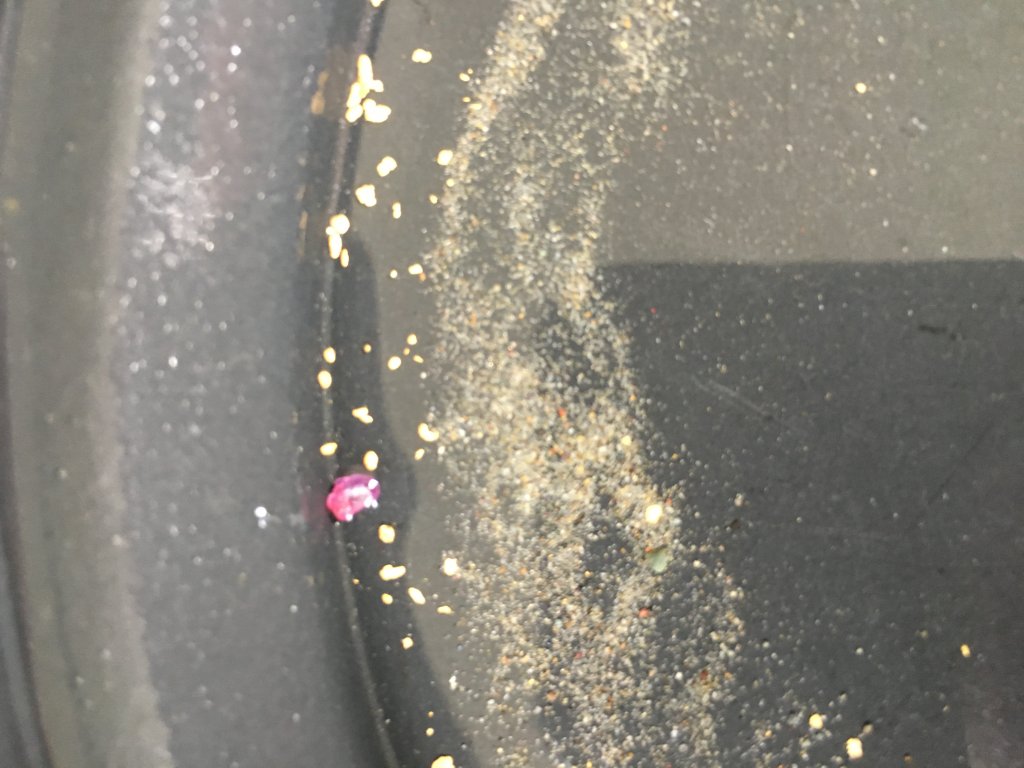-
Please join our new sister site dedicated to discussion of gold, silver, platinum, copper and palladium bar, coin, jewelry collecting/investing/storing/selling/buying. It would be greatly appreciated if you joined and help add a few new topics for new people to engage in.
Bullion.Forum

You are using an out of date browser. It may not display this or other websites correctly.
You should upgrade or use an alternative browser.
You should upgrade or use an alternative browser.
❓Your Mineral Identification Questions answered here
- Thread starter user 4386
- Start date

Help Support Prospecting Australia:
This site may earn a commission from merchant affiliate
links, including eBay, Amazon, and others.
Did a bit of research on it last night. Although I thought it was hard, it actually scratched easily with a small screwdriver. I'm thinking it's probably calcite? When I found it I was hoping it was topaz, but I don't think it is now.
Chiron52
Dave
I would say calcite.
- Joined
- Feb 19, 2013
- Messages
- 227
- Reaction score
- 146
Hi, 22shells, I think calcite is a bit more rhomboidal shaped, like the second picture.
Looks to be a monoclinic crystal form, if it is very easy to scratch with the screwdriver it could be gypsm (hardness 2).
Calcite is trigonal, hardness 3. calcite effervesces with diluted(10%) HLC acid or sulphuric acid, ( Try CLR).
Looks to be a monoclinic crystal form, if it is very easy to scratch with the screwdriver it could be gypsm (hardness 2).
Calcite is trigonal, hardness 3. calcite effervesces with diluted(10%) HLC acid or sulphuric acid, ( Try CLR).
Maybe moonstone.
Cheers
Doug
Cheers
Doug
- Joined
- Feb 19, 2013
- Messages
- 227
- Reaction score
- 146
Yes, I agree, but the hardness is 6.5. would need to be a very hard file to scratch it .
Thought the sheen on the previous picture was camera flash, Orthoclase Feldspar
Again hardness will be the key.
Thought the sheen on the previous picture was camera flash, Orthoclase Feldspar
Again hardness will be the key.
Looks like calcite to me.
All you need is a $2 coin, a pocket kinife blade and a bit of quartz to test most hardness. I suspect these would be harder than the coin and probably harder than the steel - almost certainly some sort of chalcedonic silica.22shells said:Thanks goldierocks, yeah that photo came up a bit dark so I took another one in the sunlight. I haven't done a hardness test yet but that would probably be the next step if photos don't work. I realize it's hard to tell just from a photo.
https://www.prospectingaustralia.com/forum/img/member-images/3817/1518500081_p2131014.jpg
You said hard - calcite is soft (hardness 3) so can be scratched by a $2 coin and easily with a pocket knife point. I agree it looks like it is a different crystal system. but keep oin mind that both crystal faces and cleavage planes for planar surfaces. Need hardness....Chiron52 said:I would say calcite.
Hardness 6.5 rules out a lot of suggestions. Are you sure it is scratched by quartz and it does not scratch quartz. Feldspars like orthoclase are really so clear because they have twinning and exsolutions - usually white, cream or even red or green (and only translucent in thin slivers). This is quite transparent. It is almost certainly not quartz. If it were harder than quartz I might have suggested topaz, although the cleavage angles look incorrect.....Keen Ken said:Yes, I agree, but the hardness is 6.5. would need to be a very hard file to scratch it .
Thought the sheen on the previous picture was camera flash, Orthoclase Feldspar
Again hardness will be the key.
Did some hardness tests:goldierocks said:All you need is a $2 coin, a pocket kinife blade and a bit of quartz to test most hardness. I suspect these would be harder than the coin and probably harder than the steel - almost certainly some sort of chalcedonic silica.22shells said:Thanks goldierocks, yeah that photo came up a bit dark so I took another one in the sunlight. I haven't done a hardness test yet but that would probably be the next step if photos don't work. I realize it's hard to tell just from a photo.
https://www.prospectingaustralia.com/forum/img/member-images/3817/1518500081_p2131014.jpg
The chalcedonic type rocks- must be fairly hard, not scratched by $2 coin (left coin traces on rock), not scratched by pocket knife, not scratched by sharp quartz crystal fragment (wore away a bit of the quartz)
The "calcite" type crystal- seems soft, not scratched by $2 coin (coin isn't real sharp), scratched easily by pocket knife, scratched easily by sharp quartz crystal fragment. Guess that rules out topaz? Only other thing it might be that I can think of could be aquamarine, but I doubt it. Likely area for aquamarine and it has been found in the area, but the shape of it doesn't look right for aqua to me.
Beryl (aquamarine) is harder than quartz, Coin doesn't have to be sharp. if softer it will leave a smear of metal on the sample. Chalcedony is much the same hardness as quartz - its correct mineralogical name is microquartz (so just very fine-grained quartz) - not the same as opal which is a different mineral.22shells said:Did some hardness tests:goldierocks said:All you need is a $2 coin, a pocket kinife blade and a bit of quartz to test most hardness. I suspect these would be harder than the coin and probably harder than the steel - almost certainly some sort of chalcedonic silica.22shells said:Thanks goldierocks, yeah that photo came up a bit dark so I took another one in the sunlight. I haven't done a hardness test yet but that would probably be the next step if photos don't work. I realize it's hard to tell just from a photo.
https://www.prospectingaustralia.com/forum/img/member-images/3817/1518500081_p2131014.jpg
The chalcedonic type rocks- must be fairly hard, not scratched by $2 coin (left coin traces on rock), not scratched by pocket knife, not scratched by sharp quartz crystal fragment (wore away a bit of the quartz)
The "calcite" type crystal- seems soft, not scratched by $2 coin (coin isn't real sharp), scratched easily by pocket knife, scratched easily by sharp quartz crystal fragment. Guess that rules out topaz? Only other thing it might be that I can think of could be aquamarine, but I doubt it. Likely area for aquamarine and it has been found in the area, but the shape of it doesn't look right for aqua to me.
Fluorite (sometimes clear) seems unlikely (can be clear but not rhombohedral shape) - apatite colour wrong and rarely shows cleavage. Things like dolomite and mmagnesite are harder than calcite (especially magnesite) but I rarely see those carbonates as transparent crystals (but can occur):
https://www.google.com.au/search?q=...AhXGX5QKHXPAD2UQ9QEIPTAK#imgrc=I1RVDjHeoNbmUM:
Magnesite can be as hard as 4.5 - so a possibility. It reacts with hot dilute hydrochloric acid (but neglibly with cold acid, unlike calcite and to a lesser extent dolomite). If you powder some finely and drop powder into a candle flame. the flame should go bright white.
https://geology.com/store/collections/
- Joined
- Feb 19, 2013
- Messages
- 227
- Reaction score
- 146
There is a transparent lightish yellow orthoclase feldspar (called Labradorite) found near Casino NSW, It looks similar in crystal structure but yellow.
The hardness is a puzzler though, "scratched easily by pocket knife" though I have managed to scratch quartz with a pen knife using extreme force, (more like a crushing fracture)a knife blade is about 5.5 to 6 from memory so leaning more towards Feldspar on that one.
Looking at an enlarged picture the internal parallel structure could be lamella twinning that occurs in the Labradorite from Casino. The top face on the first picture of the crystal does not look like cleaved face as there is a cubed piece sitting on one end that would be unlikely to be left if the piece had been cleaved, also note there is a conchoidal fracture internally in the top of the crystal that runs about 1/2 way down behind the front face and 1/2 way across the right front which would have cut across the apparent cleavage plain.
The white rocks with the dark areas look a bit like Chert or quartzite. There is a type of opalised wood that has similar colours but has a definite wood structure, Those piece are not that)
All Quartz minerals are 7 on the Mohs hardness scale, this includes Chalcedony, Agate, Quartz crystal, massive Quartz, Amethyst, Citrine, Jasper (impure form) even petrified wood that is formed from silica enrichment.
Topaz is 8
All beryls including Emerald, Morganite, Heliodor, Aquamarine, are all 7.5 to 8 on the Mohs.
Corundums are 9 Mohs scale (Ruby, Sapphire)
Diamond of course is top the list at 10
Everybody who fossicks should get themselves good hand Loupe and a copy of a good geology text book as an aid to Identifying there finds. Gemmology and Mineralogy seem to be streets apart when it comes to text books so it's probably good to have one for each.
Physical properties are the biggest clue (lustre, appearance, crystal form, hardness, cleavage etc.), then the diagnostics through Refractive index, Specific gravity, Xray fluorescence. etc
It's all part of the fun.
I love collecting the concentrates from a gold pan, drying them out and examining them under a 20x to 40X Gemological stereo microscope.
It's amazing the different type of crystal I find, even found a minute diamond crystal from some old Stanthorpe tin concentrates.
Most interesting was 3mm long green apatite crystals form another location, if only they were 3 cm :-/
Having studied Gemmology I still have a 3rd copy of Goubylins? GEMS, a fantastic reference book with outstanding photographs for it's time.
Also I have a copy of Sinnkankas? Mineralogy that I found indispensable and still pull out from time to time.
The instruments I payed big money for (and had to save to get) are now available on eBay for a fraction of the cost.
A simply hand loupe is you best tool, you may even see identifying inclusion. Now that's a whole new world! totally amazing.
Hope this helps.
The hardness is a puzzler though, "scratched easily by pocket knife" though I have managed to scratch quartz with a pen knife using extreme force, (more like a crushing fracture)a knife blade is about 5.5 to 6 from memory so leaning more towards Feldspar on that one.
Looking at an enlarged picture the internal parallel structure could be lamella twinning that occurs in the Labradorite from Casino. The top face on the first picture of the crystal does not look like cleaved face as there is a cubed piece sitting on one end that would be unlikely to be left if the piece had been cleaved, also note there is a conchoidal fracture internally in the top of the crystal that runs about 1/2 way down behind the front face and 1/2 way across the right front which would have cut across the apparent cleavage plain.
The white rocks with the dark areas look a bit like Chert or quartzite. There is a type of opalised wood that has similar colours but has a definite wood structure, Those piece are not that)
All Quartz minerals are 7 on the Mohs hardness scale, this includes Chalcedony, Agate, Quartz crystal, massive Quartz, Amethyst, Citrine, Jasper (impure form) even petrified wood that is formed from silica enrichment.
Topaz is 8
All beryls including Emerald, Morganite, Heliodor, Aquamarine, are all 7.5 to 8 on the Mohs.
Corundums are 9 Mohs scale (Ruby, Sapphire)
Diamond of course is top the list at 10
Everybody who fossicks should get themselves good hand Loupe and a copy of a good geology text book as an aid to Identifying there finds. Gemmology and Mineralogy seem to be streets apart when it comes to text books so it's probably good to have one for each.
Physical properties are the biggest clue (lustre, appearance, crystal form, hardness, cleavage etc.), then the diagnostics through Refractive index, Specific gravity, Xray fluorescence. etc
It's all part of the fun.
I love collecting the concentrates from a gold pan, drying them out and examining them under a 20x to 40X Gemological stereo microscope.
It's amazing the different type of crystal I find, even found a minute diamond crystal from some old Stanthorpe tin concentrates.
Most interesting was 3mm long green apatite crystals form another location, if only they were 3 cm :-/
Having studied Gemmology I still have a 3rd copy of Goubylins? GEMS, a fantastic reference book with outstanding photographs for it's time.
Also I have a copy of Sinnkankas? Mineralogy that I found indispensable and still pull out from time to time.
The instruments I payed big money for (and had to save to get) are now available on eBay for a fraction of the cost.
A simply hand loupe is you best tool, you may even see identifying inclusion. Now that's a whole new world! totally amazing.
Hope this helps.
Cheers guys :Y: Ken- after I run a sluice, then run the cons through the clean up sluice, then take those cons and pan them out for gold, when I get right to the end of panning I often get these tiny little red stones amongst the gold and black sand. I call them garnets, not sure if they are though but they must be heavy. Too small to test for hardness. I do have one of those small hand loupes, use it all the time.


- Joined
- Feb 19, 2013
- Messages
- 227
- Reaction score
- 146
Hi 22shells, it's a bit hard to tell from the picture, could be anything depending on where it's from, they maybe poor quality cassiterite, zircon or like you say garnet or none of the above.
Hand loupe will find crystal faces and form if there is any.
I have found small pieces of carnelian that behaves and looks similar.
I don't intend to hijack this topic, maybe someone else might know.
Hand loupe will find crystal faces and form if there is any.
I have found small pieces of carnelian that behaves and looks similar.
I don't intend to hijack this topic, maybe someone else might know.
HI Mic, Just guessing from one image. Looks like a fragment of ruby, I have found some that look the same colour at Tumbarumba. This assumes that the mineral is hard like corundum. run it over a rough tile and try scratch it with a pin. If no result it is possibly ruby. (it does not seem to be a colour found in zircons and it would be not impossible, but uncommon to be a pink sapphire) RDD
Only just noticed this post, I reckon it's a ruby as well, pink sapphires and rubies are basically both corrundum (sapphire) the only thing that really separates them is depth of colour. Deeper redish stones are rubies and lighter colours are classed as pink sapphire.
If you have a UV light shine it on the stone, rubies and pink sapphires will both flouresce a bright hot pink colour due to the chromium content in them.
I put some photos of rubies under UV light in this thread yesterday.
https://www.prospectingaustralia.com/forum/viewtopic.php?pid=398934#p398934
If you have a UV light shine it on the stone, rubies and pink sapphires will both flouresce a bright hot pink colour due to the chromium content in them.
I put some photos of rubies under UV light in this thread yesterday.
https://www.prospectingaustralia.com/forum/viewtopic.php?pid=398934#p398934
Thanks very much for your replies guys. :Y:
I tried scratching it with a pin RDD,and with my eyes I could see no discernible difference to the stone.its pretty small,maybe half matchhead size so I will have a look with the magnifying glass to confirm.The pin feels like it is sliding off the surface as opposed to getting any purchase.
I have just bought a UV torch off eBay this arvo Heatho so that might at least discount it being a Ruby/sapphire if there is no fluoresce.
I tried scratching it with a pin RDD,and with my eyes I could see no discernible difference to the stone.its pretty small,maybe half matchhead size so I will have a look with the magnifying glass to confirm.The pin feels like it is sliding off the surface as opposed to getting any purchase.
I have just bought a UV torch off eBay this arvo Heatho so that might at least discount it being a Ruby/sapphire if there is no fluoresce.
Similar threads
- Replies
- 8
- Views
- 8K
- Replies
- 76
- Views
- 25K
- Replies
- 41
- Views
- 15K





